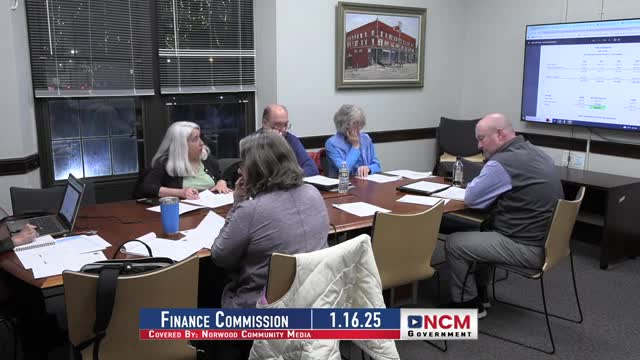Finance Commission keeps conservative $900,000 new-growth estimate as members flag large commercial projects and unknown state aid
January 17, 2025 | Town of Norwood, Norfolk County, Massachusetts
This article was created by AI summarizing key points discussed. AI makes mistakes, so for full details and context, please refer to the video of the full meeting. Please report any errors so we can fix them. Report an error »

The Town of Norwood Finance Commission reviewed five years of new-growth data and recommended using a conservative $900,000 new-growth estimate as staff and commissioners prepare the FY26 budget.
The commission’s finance staff presented a final new-growth figure used when the tax rate was set in December and walked members through likely sources of incremental value. Jeff, finance staff in the manager’s office, identified four principal prospects for captured growth: FM Global’s site work, a potential Moderna-related capture, and two planned residential subdivisions — one 16-unit and one 8-unit. Jeff said FM Global could account for the largest share and that the town should conservatively expect to capture about 50% of that firm’s reported growth in the next assessment cycle.
Why it matters: new-growth figures feed the town’s property-tax base and set part of the operating budget baseline. Commissioners emphasized caution because Department of Revenue (DOR) valuation rules can change the final captured amount and because residential subdivisions and large commercial developments remain partly speculative.
Jeff told the commission that the new-growth number reported when the tax rate was set is final for the tax-rate calculation but that DOR will ultimately validate the increments. He and other members discussed how demolition of older buildings and construction of new structures are treated: new growth equals the net increase in assessed value after accounting for removed/repurposed structures. The group noted that if FM Global’s construction is validated at a high value, the town’s $900,000 budgeting target could prove conservative.
Commissioners also reviewed local receipts line by line. Jeff proposed modest increases for meals tax and room excise tax based on a three‑year trend, recommended a slight uptick in motor‑vehicle excise, and proposed conservative assumptions for ambulance revenue and fines. For investment income, staff modeled a $50,000,000 average cash balance earning roughly 3% across the year; commissioners flagged uncertainty in that projection and asked for follow-up with the treasurer.
State aid remains the largest open variable. The commission noted the governor’s budget was due the week after the meeting and that current consensus revenue forecasts suggested only modest statewide increases; as a result, the commission treated state aid as uncertain and retained conservative placeholders in the FY26 projections.
Action at the start of the meeting: the commission approved minutes from its Nov. 21 meeting. That motion passed unanimously on a voice vote; one member, Eric Fleming, arrived late and did not vote on the minutes.
Looking ahead, staff will continue to monitor DOR valuation determinations for the large commercial prospects and update commissioners as new information arrives. The Finance Commission reiterated a preference for conservative revenue assumptions while continuing liaison discussions with assessors and the treasurer.
The commission’s finance staff presented a final new-growth figure used when the tax rate was set in December and walked members through likely sources of incremental value. Jeff, finance staff in the manager’s office, identified four principal prospects for captured growth: FM Global’s site work, a potential Moderna-related capture, and two planned residential subdivisions — one 16-unit and one 8-unit. Jeff said FM Global could account for the largest share and that the town should conservatively expect to capture about 50% of that firm’s reported growth in the next assessment cycle.
Why it matters: new-growth figures feed the town’s property-tax base and set part of the operating budget baseline. Commissioners emphasized caution because Department of Revenue (DOR) valuation rules can change the final captured amount and because residential subdivisions and large commercial developments remain partly speculative.
Jeff told the commission that the new-growth number reported when the tax rate was set is final for the tax-rate calculation but that DOR will ultimately validate the increments. He and other members discussed how demolition of older buildings and construction of new structures are treated: new growth equals the net increase in assessed value after accounting for removed/repurposed structures. The group noted that if FM Global’s construction is validated at a high value, the town’s $900,000 budgeting target could prove conservative.
Commissioners also reviewed local receipts line by line. Jeff proposed modest increases for meals tax and room excise tax based on a three‑year trend, recommended a slight uptick in motor‑vehicle excise, and proposed conservative assumptions for ambulance revenue and fines. For investment income, staff modeled a $50,000,000 average cash balance earning roughly 3% across the year; commissioners flagged uncertainty in that projection and asked for follow-up with the treasurer.
State aid remains the largest open variable. The commission noted the governor’s budget was due the week after the meeting and that current consensus revenue forecasts suggested only modest statewide increases; as a result, the commission treated state aid as uncertain and retained conservative placeholders in the FY26 projections.
Action at the start of the meeting: the commission approved minutes from its Nov. 21 meeting. That motion passed unanimously on a voice vote; one member, Eric Fleming, arrived late and did not vote on the minutes.
Looking ahead, staff will continue to monitor DOR valuation determinations for the large commercial prospects and update commissioners as new information arrives. The Finance Commission reiterated a preference for conservative revenue assumptions while continuing liaison discussions with assessors and the treasurer.
View full meeting
This article is based on a recent meeting—watch the full video and explore the complete transcript for deeper insights into the discussion.
View full meeting
